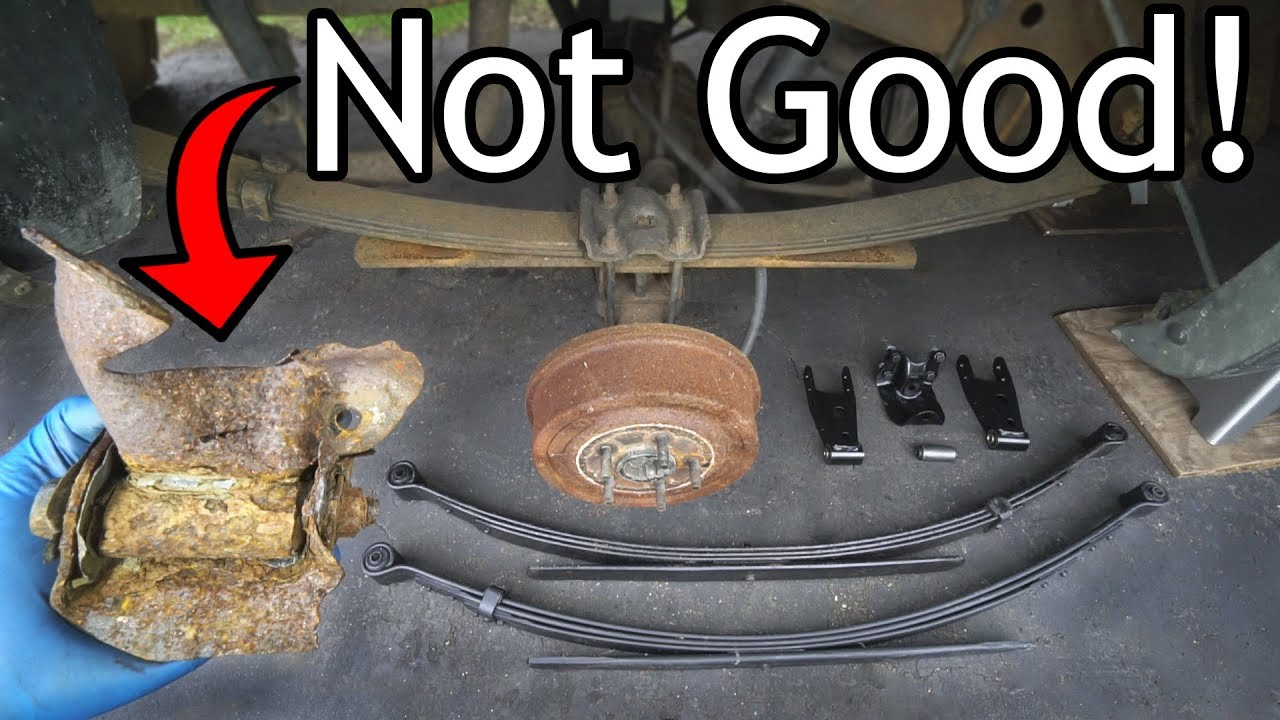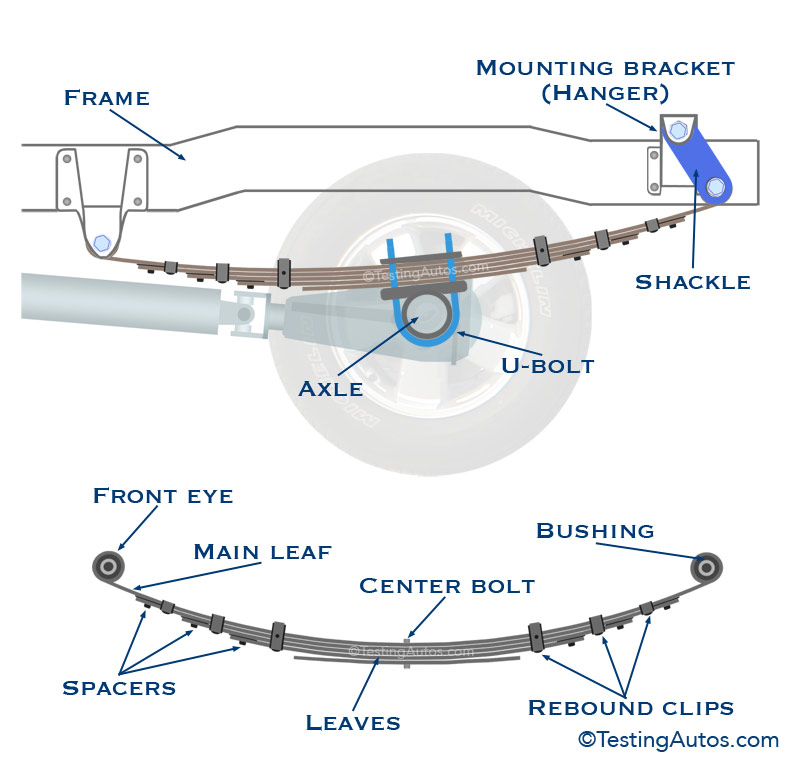Have you ever felt a strange wobble or heard an unsettling creak from your vehicle’s rear end? These might be signs that your leaf springs are wearing out.
As a crucial component of your vehicle’s suspension system, leaf springs play an essential role in supporting weight, absorbing road shocks, and maintaining a smooth ride. But, like all mechanical parts, they can wear out over time, potentially leading to uncomfortable rides or even safety hazards.
We’ll explore the signs of wear and tear in leaf springs, how they affect your driving experience, and most importantly, what you can do about it. Keep reading to discover how to ensure your vehicle remains safe and comfortable on the road.

Credit: www.tow-max.com
Leaf Springs Explained
Leaf springs are a key part of many vehicles. They help support the vehicle’s weight. They also help keep the ride smooth. Each spring has several layers, called leaves. These leaves are made of metal. The leaves are stacked on top of each other. Bolts hold them together. Leaf springs are strong and long-lasting. But they can wear out over time.
These springs can break if too much weight is put on them. They can also rust if not cared for. Regular checks can help keep them in good shape. Keep them clean and lubricated. This helps them last longer.
Leaf springs have been used for a long time. People first used them in horse-drawn carriages. They helped make the ride smoother. In the past, springs were made from wood. Later, they were made from iron. Today, they are made from steel. This makes them stronger and more durable.
Over the years, springs have changed a lot. They are now used in many vehicles, like trucks and SUVs. These springs are important for heavy loads. They help keep vehicles stable. They also help with balance when driving.
Causes Of Leaf Spring Wear
Leaf springs can wear out due to heavy loads, rough roads, and corrosion. These factors stress the metal, causing fatigue and eventual failure. Regular inspection helps identify early signs of wear and prolongs their lifespan.
Environmental Factors
Leaf springs face tough conditions. Rain and snow make them rust. Salt from roads can damage them. Mud and dirt stick to them. This can cause wear over time. Extreme temperatures can weaken them. Cold makes them brittle. Heat can soften them. Dust adds friction. This leads to wear. Humidity can also be a factor. All these elements affect leaf springs. Regular cleaning can help. It keeps them in better shape.
Load And Usage Impact
Heavy loads stress leaf springs. They bend and strain under weight. Frequent use adds wear. Off-road driving is tough on them. Bumps and potholes can cause damage. Overloading is a big problem. It can cause breakage. Improper installation can affect them. Incorrect size or type can lead to failure. Regular checks are important. They help spot problems early. Proper maintenance can extend their life.
Signs Of Wear And Damage
Leaf springs can show signs of wear. Look for rust or cracks on the surface. Check if the spring is bent or sagging. A sagging spring may affect your vehicle’s balance. Missing clips or broken leaves also indicate damage. These issues can lead to more problems. Inspecting them early is important. Regular checks can prevent further damage.
Uneven tire wear can be a sign. Your car might bounce more than usual. You may feel a rough ride on bumpy roads. Listen for creaking or clunking noises. These noises happen when the springs are worn. Your vehicle might lean to one side. A leaning car can be hard to drive. Fixing worn springs can improve your ride.

Credit: www.reddit.com
Consequences Of Worn Leaf Springs
Worn leaf springs can make driving unsafe. They may cause the vehicle to sway or bounce more than usual. This can make the car harder to control, especially during turns. Uneven tire wear might also occur, reducing grip on the road. This can lead to longer stopping distances, increasing the chance of accidents. Broken leaf springs may even snap, risking a sudden loss of control.
Handling becomes tricky with worn leaf springs. The car might lean more in corners. This can feel unstable and uncomfortable. Poor handling affects how the car steers. It may drift or pull to one side. This makes driving tiring and unsafe. Regular checks are needed to ensure springs are in good shape. Proper maintenance keeps the vehicle stable and safe.
Maintenance And Longevity
Regular checks keep leaf springs in good shape. Look for any rust or cracks. These can cause big problems. Ensure all parts are tight. Loose parts can lead to wear. Listen for squeaky noises. They may mean trouble. Check the alignment too. Misaligned springs wear out faster. Always follow a schedule for inspections. This helps spot issues early.
Use lubricant to prevent rust. It keeps springs smooth. Avoid overloading the vehicle. Too much weight stresses the springs. Drive carefully on rough roads. Bumps can damage springs. Keep them clean from dirt and debris. Clean springs last longer. Replace worn parts quickly. New parts help maintain balance. Remember, a little care goes a long way.

Credit: www.testingautos.com
Repair And Replacement Options
Repairing or replacing leaf springs can be costly. Prices vary based on the vehicle type. Some repairs might cost less than $100. But new parts can be more expensive. Always check if the repair is enough. Sometimes, replacement is the best choice.
Fixing leaf springs yourself saves money. Tools and knowledge are needed. Mistakes can lead to more damage. Professional servicesoffer expertise. They ensure the job is done right. Paying a professional gives peace of mind. Think about your skills before choosing.
Future Of Leaf Spring Technology
Leaf springs, essential in vehicle suspension, do wear out over time. Material fatigue and environmental factors contribute to this wear. Advances in technology aim to enhance durability and performance, promising a longer lifespan for future leaf springs.
Innovations In Materials
Leaf springs are improving with new materials. Stronger materials make springs last longer. They help cars carry heavy loads. Engineers use lightweight materialsfor better fuel use. Some new materials stop rust. Rust can damage springs. These improvements make cars safer.
Better materials keep springs from breaking. This helps cars stay smooth on bumpy roads. Cars can go faster without spring problems. New materials save money on repairs. They make leaf springs more reliable.
Potential Alternatives
Many people want different options for springs. Coil springs are one option. They are small and fit in cars easily. Coil springs help with smooth rides. Air springs are another choice. They use air to support cars. These springs are good for heavy vehicles. Air springs change shape for different road conditions.
Rubber springs are another idea. They do not rust. Rubber springs are quiet on the road. Each type has its own benefits. People choose the best spring for their needs.
Conclusion
Leaf springs do wear out over time. Regular checks can help spot issues early. Look for signs like sagging or unusual noises. A smooth ride depends on healthy leaf springs. Replacing them ensures safety and performance. Neglecting worn springs can lead to bigger problems.
It’s a simple yet important maintenance task. Keep your vehicle in top condition. Regular inspections can save you headaches later. Remember, a well-maintained vehicle lasts longer. Stay proactive and enjoy a smoother drive. Make checking leaf springs a routine habit.
Your vehicle will thank you.
